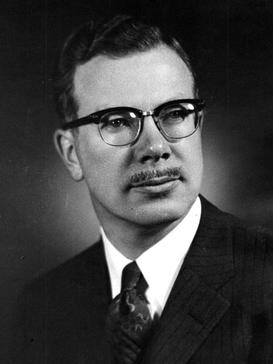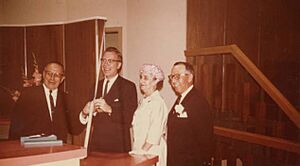Dufferin Roblin facts for kids
Quick facts for kids
Dufferin Roblin
|
|
|---|---|
 |
|
| 14th Premier of Manitoba | |
| In office June 30, 1958 – November 27, 1967 |
|
| Monarch | Elizabeth II |
| Lieutenant Governor | John S. McDiarmid Errick Willis Richard S. Bowles |
| Preceded by | Douglas Lloyd Campbell |
| Succeeded by | Walter Weir |
| Senator for Red River, Manitoba | |
| In office March 23, 1978 – June 17, 1992 |
|
| Appointed by | Pierre Trudeau |
| Member of the Legislative Assembly of Manitoba for Wolseley | |
| In office June 16, 1958 – May 1, 1968 |
|
| Preceded by | district created |
| Succeeded by | Leonard Claydon |
| Member of the Legislative Assembly of Manitoba for Winnipeg South | |
| In office November 10, 1949 – June 16, 1958 Serving with John S. McDiarmid, Ronald Turner, Lloyd Stinson, Gurney Evans
|
|
| Preceded by | district created |
| Succeeded by | district abolished |
| Personal details | |
| Born | June 17, 1917 Winnipeg, Manitoba, Canada |
| Died | May 30, 2010 (aged 92) Winnipeg, Manitoba, Canada |
| Political party | Progressive Conservative Party of Manitoba |
| Other political affiliations |
Progressive Conservative |
| Spouse |
Mary MacKay
(m. 1958) |
| Signature | |
Dufferin "Duff" Roblin PC CC OM (June 17, 1917 – May 30, 2010) was an important Canadian leader. He was a successful businessman and politician. Roblin served as the 14th premier of Manitoba from 1958 to 1967. Later, he became a Senator and a government leader. He was the grandson of another Manitoba Premier, Sir Rodmond Roblin. His family had a long history in Canadian politics.
Contents
Early Life and Military Service
Dufferin Roblin was born in Winnipeg, Manitoba. He studied at the University of Manitoba and the University of Chicago. Before he entered politics, he worked as a car dealer.
During World War II, Roblin served in the Royal Canadian Air Force from 1940 to 1946. He reached the rank of Wing Commander. This experience helped shape his leadership skills.
Starting in Politics
Like his grandfather, Roblin was a member of Manitoba's Conservative Party. This party later changed its name to the Progressive Conservative Party in 1942.
In the 1940s, the Manitoba Conservatives were part of a "coalition government." This means different political parties worked together to govern. Roblin, however, did not agree with this arrangement.
Becoming a Provincial Leader
Roblin was elected to the Legislative Assembly of Manitoba in 1949. He ran as an "Independent Progressive Conservative" because he opposed the coalition government. He quickly became a strong voice for those who wanted the Conservative Party to be independent.
In 1954, Roblin decided to run for the leadership of the Progressive Conservative Party. He worked hard to build support across the province. He won the leadership, showing his ability to connect with people. For the next four years, he focused on making the party stronger.
Roblin believed the government should do more to help people. He promised to expand government services if he was elected Premier.
Premier of Manitoba
Under Roblin's leadership, the Progressive Conservatives became the largest party in the legislature in the 1958 provincial election. They won 26 seats. Roblin himself was elected for the new area of Wolseley in Winnipeg.
The Manitoba CCF (a different political party) agreed to let the Tories form a "minority government." This meant Roblin became Premier, ending 35 years of Liberal-Progressive government in Manitoba.
Roblin's government quickly made many important changes. These changes were supported by the CCF. His government improved highways and created new parks. One of his most famous projects was building the Red River Floodway around Winnipeg. People often called it "Duff's Ditch." This project helps protect Winnipeg from floods.
His government also brought back French instruction in schools. They modernized hospitals and expanded social programs to help people. They also improved education after high school. Roblin's team also helped develop cities by combining different towns in the Winnipeg area into one big metropolitan area. For younger students, they built modern, larger schools to replace older, smaller ones.
The Progressive Conservatives won big victories in the 1962 and 1966 elections. Roblin was a very popular leader.
Moving to Federal Politics
Roblin resigned as Premier in 1967. He wanted to run for the leadership of the federal Progressive Conservative Party. He ran a strong campaign but came in second place.
In 1970, he was given the Order of Canada, a very high honour.
In 1978, Prime Minister Pierre Trudeau appointed Roblin to the Senate. The Senate is a part of Canada's Parliament. He represented the Manitoba region of Red River.
Roblin served as a government leader in the Senate when Brian Mulroney became Prime Minister in 1984. He was very interested in helping African countries develop their economies.
Roblin retired from the Senate on June 17, 1992, when he turned 75. In 1999, he published his memoirs, a book about his life, called Speaking for Myself.
Roblin, a veteran of World War II, represented Manitoba at the 60th Anniversary of D-Day in France. He joined Prince Charles and the Prime Ministers of Canada and France to remember the Canadian soldiers who died on that day in 1944.
Dufferin Roblin passed away on May 30, 2010, at the age of 92. Many people remembered him as a leader who brought Manitoba into the modern era.
Images for kids
Archives
Records and documents related to Dufferin Roblin can be found at the Archives of Manitoba and Library and Archives Canada.



